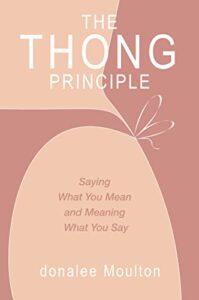The Thong Principle: Saying What You Mean and Meaning What You Say by donalee Moulton
Publisher: Business Expert Press
Genre: Non-Fiction, Contemporary
Rating: 3 Stars
Reviewed by AstilbeThe Thong Principle has little to do with beachwear and everything to do with effective communication. It’s about ensuring messages are successful for the sender – and the receiver.
The book delves into the elements that comprise successful communications – conciseness, clarity, concreteness, and much more. It also puts those elements into context. Communications that miss the mark confuse and annoy. They fail to deliver their message. They damage our credibility and erode goodwill.
The Thong Principle overflows with real-world examples to help us understand why we fail to get our messages across as intended.
Then it explains how we can anticipate, identify, and correct errors and oversights. This is both at the highest level – including building and maintaining trust – and down in the weeds where even one word makes a difference.
The Thong Principle will draw you in and keep you reading with:
Examples
Exercises
Information that resonates.
It’s also funny. Laughter and learning are wonderful partners.
Clear communication makes everything easier.
The most memorable passages were the ones that shared stories about various written forms of communication that accidentally gave their recipients the wrong first impression. For example, one letter began with compliments only to abruptly deny a request to place a sign on private property. It was a jarring thing for me to read and was no doubt even more upsetting for the person who had made the request. Tone matters, and anecdotes like this one explained why a softer approach does not necessarily have to come with flowery language or vague writing.
It would have been helpful to have more concrete information about what to look for when revising a piece of business writing. While this was covered briefly in a section or two, I would have appreciated a more condensed list of what should and should not be included in, say, a letter to a client or an email to one’s boss. I would have happily chosen a higher star rating if it had been included.
I appreciated how many examples the author shared of messages that were and were not easy to understand. Her commentary about what made one message effective and another one too dense or vague was even more helpful. This is the sort of writing advice that works better when the audience has plenty of opportunities to practice their skills and learn to correct imprecise communication.
The Thong Principle: Saying What You Mean and Meaning What You Say was a thought-provoking read.























